 |
||||||
|
One Hundred Year History of Lemon-Monroe Schools 1881-1981 (from the 1981 yearbook) |
|||||
|
|||||
The history of Monroe High School is closely connected to the elementary school. In
1868 a committee was appointed by the board of education to examine the school at
Since the high school was not a township school, decisions concerning it were not made by the township board of education but by the board of directors from the schools districts which attended the high school. Thus we have no records of decisions made concerning the high school until 1921. In 1922 two letters were Received by the Lemon Township Board of Education from fathers who were sending their children from Middletown High School because, "The High School you pretend to maintain at Monroe Butler County is not a legal School; and that it is not in fact teaching all the branches that are required to be taught to comply with the law... That you are trying to (with) one teacher to teach more than he is able; and that it's only a makeshift." One month later the board held a meeting to discuss organizing a first class township high school located in Monroe. Plans were made to add to the building in Monroe, but in november 1911 the stated condemned the building. The board voted to build a new building for $16,000. funds from the old Monroe High School were transformed to Lemon Township High School. In 1911 the school had two teachers, Ida Masser (also spelled Moser) and J.L. Miller. For many years the board had a traveling teacher who went to all sub districts. In 1911 this teacher would begin music in the high school--R. E. Morrison was music supervisor in the rural schools of Wayne, Madison and Lemon Townships for about ten years, making the 30-35 mile trip daily over mud roads by motorcycle. All students took the same classes with no electives available. Among the requirements was four years of Latin. Ruth Swearington Finkbone, 1910, and Ada Mitzel Chance, 1912, recall travelling to Monroe from Liberty Township by Cincinnati-Dayton Road, a mud road. Not only was ada Mitzel a tuition student, but her father had to rent a stable in Monroe for her horse and carriage. (We learned buggy races were frequent on the way home from school.) During the senior year of Ada Mitzel the old building was torn down, and high school classes were held in Steward Hall (the house east of Riggs Funeral Home). Commencement exercises for all graduating classes were held in the Methodist Church. Senior received a class pin instead of a class ring, which would appearing the early 20's. As early as 1910 the colors of the graduation class were blue and gold.
We know of only one student who left the high school to serve in World War I. Marion boyd was older than his classmates because he had dropped out of school and then returned two years later. He joined the army during his senior year, 1918, and did not graduate. During the early days of the school, boys and girls played baseball together, this being their only activity. The Butler County Fair was a great attraction, and two days of vacation were given each year at county fair time. School began the day after Labor Day and was a 9 month school. Christmas vacation did not usually begin until christmas Eve. Sports competition with other schools began in 1920 when the board adopted the Butler county Athletic Association rules ode township schools. Baseball was the number one sport. Tennis was played on two clay courts that were also used by the intraclass volleyball teams. An all school prom was held as early as 1918. Transportation and a freer supply of money led to many changes in the 20's. A small orchestra was part of the music program. The board instituted a lecture series with four lectures per year, paid for by suggestions of the Current Events Club. (Monroe woman organized to study events and promote intellectual and social culture of its members), a cafeteria was begun December 9, 1921. With the financial backing of the Current Events Club and the willingness of each member to help, the hot lunch idea was a success. The cafeteria would furnish warm, correctly balanced lunches to pupils at a low cost. Milk was 2 (cents) a glass, cocoa 3 (cents), sandwiches 3 (cents) some substantial dish 41/2 (cents), and fruit 3 (cents). By 1922 the school employed four teachers. At this time one half the credit was given for "home projects in sewing, canning, pig raising, garden, field, poultry and music". Board minutes record a receipt for $100 from Dr. S. a. Livingston who had subscribed $300 toward a library at Monroe High School. Livingston was the pastor of the Presbyterian Church, beginning his pastorate in Monroe in 1886.
In 1921 land had been purchased anticipating an addition to the growing school. In 1923 the board entered an agreement with the architect for improving the building. "The auditorium will be the main feature of the new building because the basketball floor and the main play room will be just in front of the elevated, permanent stage. The farm shop will be in the basement also. Since the valuable addition of a Smith-Hughes agriculture teacher to our school, it is necessary to have an extra room. This year we were forced to use the old store room and have it made into a suitable farmshop room. On the first floor will be the four recitation rooms. Since there are four rooms it is impossible to have a confliction of any two classes because we have only four high school teachers. On the second floor there will be a study hall, library, laboratory and two restrooms. One for the boys and one for the girls... In the central hall there will be lockers in the wall for each particular student."
The new cafeteria opened November 14, 1925. The domestic science classes managed it, with the two ladies hired to do the cooking. Each high school girl had to take her turn serving one day a week. This would keep down the expense of hired help. The domestic science classes made their gym suits. These gym suits also served as the girls' basketball uniforms. The first school newspaper, The Tattler, was printed in 1925. It continued until 1930 when it was replaced by The Lemon. The Tattle not only had stories about school events, but included pictures and the same kinds of articles that had been in the annual. One of the articles in the February 1929 edition of The Tattler was about the purchase of a radio for the school. Apparently several meetings were held and several sets tested before the school finally decided to purchase an 8 tube set, costing $127.50. Another interesting item mentioned in a later paper was the touring of the senior class to Cincinnati, October 22, 1929 to see President Hoover. In the early 30's The Lemon was the same kind of paper but was later a mimeographed paper.
Freshman and sophomore students from Mayfield, Rolling Mill Park, amanda and Excello were required to attend Monroe High School beginning with the 1929-30 school year. In 1936 pupils from the Maple Park area were required to attend Monroe. By 1937 the school was finally a high school for all of Lemon Township. The faculty increased dramatically. Twenty-two single teachers had to find find lodgings in Monroe. They remember the hospitality of Louise Fogarty who prepared dinner each evening for the entire group. The growth of the school was slow in the early years. In 1886 five students graduated; in 1922 ten students graduated. With the addition of the Amanda area was a rapid increase. The freshman class of 1933 had one hundred two members. The largest group to graduate from Monroe was the class of 1871 which had 274 members. A total of 7,450 students have graduated from the school, with almost 7,000 of those being since '36. Students saw little change in the high school during the depression years. Eight months of school were held during 32-33 and 33-34. The agriculture class was dropped, but commercial classes, which had begun in 1927, were continued because of their popularity. Teachers were not paid for extracurricular activities so these were not affected. Salaries of all personnel were reduced during this period. One year after receiving their pay September and October, teachers were notified the board was out of money. They went without pay until April. The community extended them credit. We also learned some students were so concerned that they gave them gifts of money. In 1934 the school made application in north Central Association of college and High Schools. The school celebrated its "semi-centennial" in 1936. (50 years since the first class had graduated). A pageant was held depicting various stages of the school's development, and a special edition of The Lemon was dedicated to "50 Years of Progress".
In 1938 bids were opened for another addition to the school. This addition is the present cafeteria and the rooms above it. By 1941 the school was feeling the effects of World War II. "Ray 'Pete" Black was the first Monreite toward whom Uncle Sam pointed his finger. Ray left september, 1942 before he was given a chair in homeroom." Conserving all materials was urged by the board. This notice was sent to the school. "In view of the rising prices of everyday essentials and supplies in the school, the board urges the faculty cafeteria managers and janitors of our school to conserve in every way possible on all supplies used in the school, whether furnished by the board or parents. We suggest use of both sides of paper for paper has become a key material in which a serious shortage is threatened..... If most of it were salvaged, there would be no lack of packaging for supplies to soldiers and sailors. Army ordnance plants use 30,000 tons of paper materials a month for packing shells." Rationing stamps created problems for the cafeteria, and gasoline rationing forced elimination of busses taking spectators to ball games. THE MERCURY, the school paper since 1939, was sent to all alumni in the service. In 1941 the "previous resolution providing for non-employment of married lady teachers" was suspended for the duration of the war. The government asked for, and received, typewriters from Monroe. Tentative plans were drawn for a new building, but because of scarcity and cost of materials plans were delayed. Detailed reasons for the need for a new bus had to be given before the board could purchase a new bus. By 1947 the servicemen were returning home, and several of them would return to high school. A delegation of students who failed to make necessary credits the past year approached the school board in June of 1945 and asked for a summer school. Summer school was held that summer with students from Middletown also in attendance. "One executive head of all Lemon Local Schools" was the decision of the board in 1946. C.W. Young was the first and only superintendent of Lemon Township Schools. He had been superintendent of the Monroe school since 1937. Ten acres west of the school was purchased from John Zecher in 1948. This land was to be used as an athletic field. W. E. Davis was employed as the principal of the high school in 1949. He retained this position until 1970 when he took an administrative position in the Central Office. After his death in 1977, the Principal's Association established a scholarship in his memory, to be given to an outstanding Monroe Senior. Many of the current organizations at Monroe were begun in the thirties and forties. Student Council was re-established in 1932. In 1935 the W.C. Dress Chapter of the National Honor Society was formed. Dress was a former principal who had recently died. THE MONOCLE, the first yearbook since 1924, was published in 1938. (A mimeographed yearbook, THE ROCKET, was printed in 1937,) The sponsors, a group of six girls, M-O-N-R-O-E, was added to the band in 1947. Many musical productions were given at Monroe through the years, but it was the 48-49 school year that the Showboat Follies appeared, followed by Campus Follies in 49-50. The Wizard of Oz was the first Broadway musical Follies presentation. It was done in 1959. Pat Townsend was crowned queen and Jim Harrison king of the of the first homecoming at Monroe November 3, 1950. The cheerleaders were the attendants.
The most perplexing research we have done involves the name of the school. Nearly all alumni swear they have graduated from Monroe High School and are surprised to look at their diploma to find a different name on it. The official name of the school has not been Monroe high School since 1911 when it became Lemon Township High School. During the early 20's the school was called Monroe Lemon township High School. According to John Robinson, principal 1931-1938, the school was first called Lemon-Monroe during his administration. This name appears on many school programs but all diplomas from the 30's and 40's have Lemon Township High School. To illustrate the confusion, the commencement program of one year reads "annual commencement of Lemon-Monroe High School at Monroe High School Auditorium" and the diploma has Monroe Lemon Township High School. When the 1948 section was added, the name over the entrance was Lemon Township High School. There is no official name change recorded in the board of education minutes, but these minutes refer to the school as Lemon-Monroe first the first time in 1952. The class composite of '52 is the first to have the Lemon-Monroe name. The specific change is not recorded, but we assume this to be the changing of Lemon-Monroe over the entrance. Our school is now officially Lemon-Monroe, but in this centennial year it is still frequently called Monroe.
The school mascot was updated in 1956; the fighting hornet, instead of the golden hornet, would be the rallying point for Monroe fans. Thespian Troupe 1709 was begun during the 57-58 school year. (Watch "History of the Hornet" video) Monroe elementary school was built in 1954. This was the first time in the school's history that grades 1-12 were not in the same building. The seventh and eighth grades left the high school in 1968, and the ninth graders attended the freshman high school in 1969. Monroe remained a three year high school until 1981 when the Freshman High School was closed and ninth graders returned to Monroe.
Students of Monroe were very fortunate in 1969. School was not in session when a tornado touched down in Monroe on May 8. There was little structural damage to the building, but much broken glass would have certainly caused injury if students had been in the southern classrooms. Memorial stadium was badly damaged. All games in the next fall were played during the day because of damage to lights. A "cyclone" had broken windows at the school in 1928, but no damage was done then. The classes of the early 70's were outstanding in many ways. The football team was Mid-Miami league champs in 69, 70, 71 and 72. Monroe had its own version of social protest and attempts to change the world. The stinging satire of an underground newspaper kept everyone aware of a different point of view. Then there was the class that did not elect the usual class officers, but had a five member council, with each member being of equal importance. Although highly discouraged by the administration, some students wore black armbands to protest U.S. involvement in Vietnam. These were the days when men on the faculty were no longer required to wear a coat and tie, and women actually wore slacks to school. We realize at the writing of this history we are too close to these years to properly evaluate their significance. The title IX Federal Program, 1969, initiated drastic changes in the athletic programs at Monroe. According to this legislation all schools receiving federal money must have equal sports opportunities for males and females. Gold, cross country, soccer, football, volleyball, baseball, basketball, wrestling, softball, track and tennis teams competed for students and for use of the facilities.
In recent years there has been declining enrollment in the Middletown School District. During the 1980-81 school year elementary were closed and boundary lines were changed. You will read of these effects on Lemon-Monroe in the remianing pages of the 1982 Monocle. Want to learn more about the History of Lemon-Monroe High School? - Watch Video SOURCE: This history was researched and written by Irene and Jim Orem and published in the 1981 yearbook |
|||||
| Back to top |
Developers: Ryan Cho, Donny Blevins, Tom Burklow & Web Design - I students
![]()






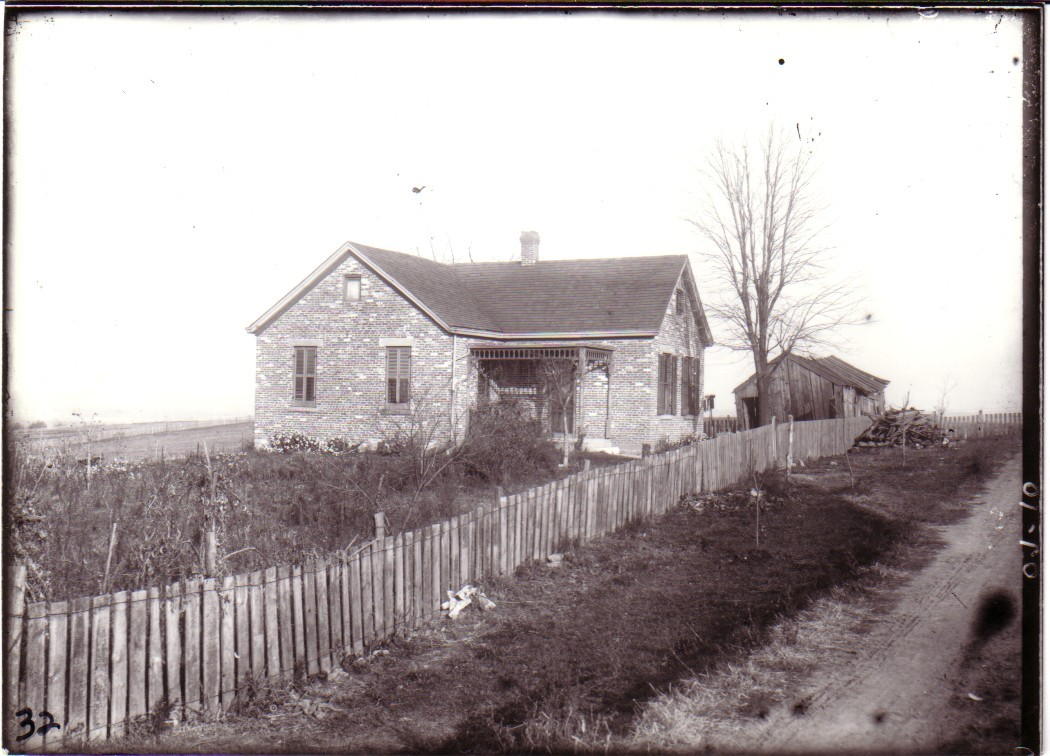
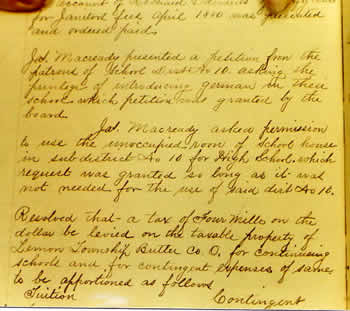
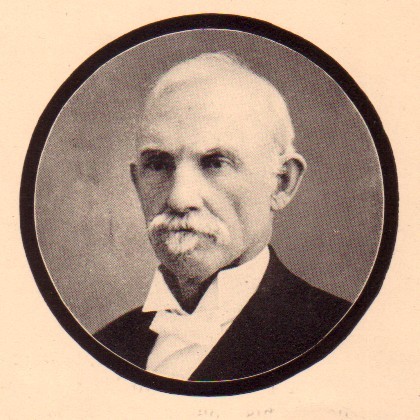 On April 18, 1881 Dr. James Macready, who had been on the Lemon Township Board since
1868, asked permission to use the unoccupied room of the schoolhouse in sub district
10 for high school. The request was granted so long as it was not needed for the
elementary school. Dr. Macready would have two of his own children in the first
graduating class. The school was made up of Red Buck, Reed, Oak Hill, Mulford and
Monroe Districts. J.M. Hunt was the first teacher in the school. Years later Ella
Cheesman Vance remembered, "I can remember how some people talked against the high
school and many expressed the opinion that it would only be for a short time." The
first year there was only money for half of a school year. The next year S.I.
McClellan came as a teacher and remained until 1888. In 1886 the first class
graduated from Monroe with five members, John Mcready, Ella Cheesman Vance, Elmer
R. Lowry, Ella Macready Vorhis, and Edgar Eugene Stewart. Each year thereafter would
have a graduating class except 1897. There were to have been two graduates that year
but Rose Conover died in late winter and Clarence Warner decided (he) did not want
to graduate by himself, so he quit school in the spring.
On April 18, 1881 Dr. James Macready, who had been on the Lemon Township Board since
1868, asked permission to use the unoccupied room of the schoolhouse in sub district
10 for high school. The request was granted so long as it was not needed for the
elementary school. Dr. Macready would have two of his own children in the first
graduating class. The school was made up of Red Buck, Reed, Oak Hill, Mulford and
Monroe Districts. J.M. Hunt was the first teacher in the school. Years later Ella
Cheesman Vance remembered, "I can remember how some people talked against the high
school and many expressed the opinion that it would only be for a short time." The
first year there was only money for half of a school year. The next year S.I.
McClellan came as a teacher and remained until 1888. In 1886 the first class
graduated from Monroe with five members, John Mcready, Ella Cheesman Vance, Elmer
R. Lowry, Ella Macready Vorhis, and Edgar Eugene Stewart. Each year thereafter would
have a graduating class except 1897. There were to have been two graduates that year
but Rose Conover died in late winter and Clarence Warner decided (he) did not want
to graduate by himself, so he quit school in the spring.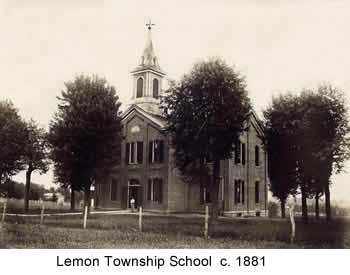
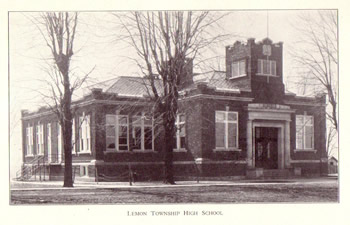
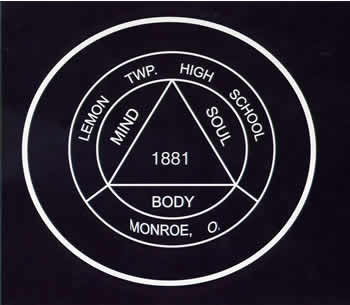
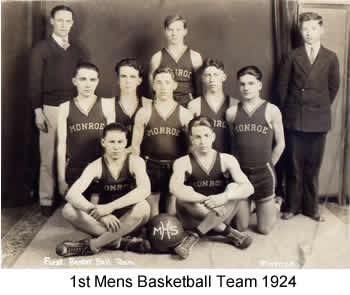
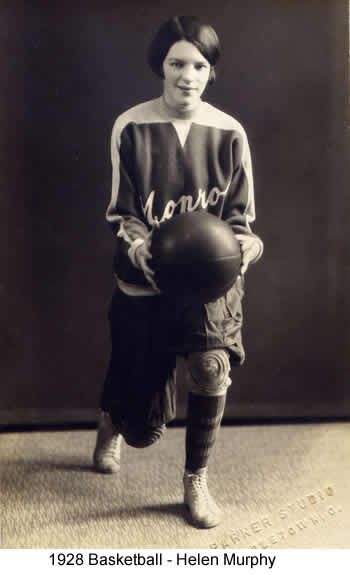
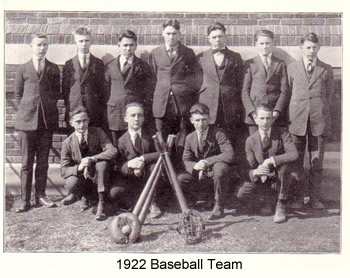
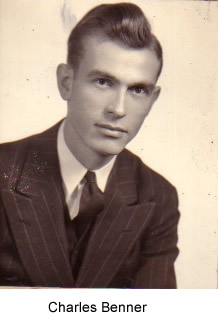
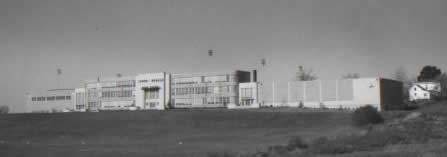
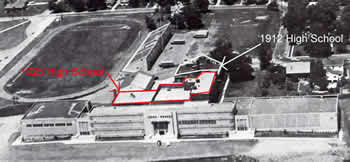
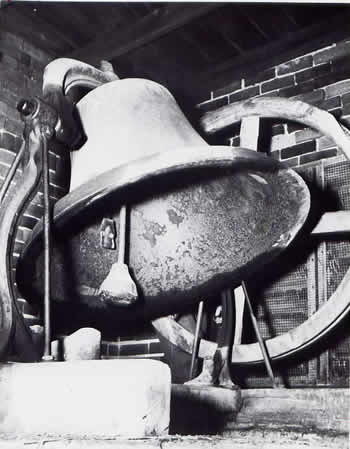
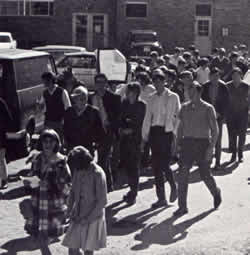 Perhaps the bleakest days in Monroe history occurred September of 1979. After several unsuccessful tax levies the school board cancelled all extra-curricular activities. The day after the last levy defeat, students walked out of school protesting this action. A week later teachers went on strike, forcing the closing of the school. The strike lasted six days, but the disruptions made October seem like another beginning to the school year.
Perhaps the bleakest days in Monroe history occurred September of 1979. After several unsuccessful tax levies the school board cancelled all extra-curricular activities. The day after the last levy defeat, students walked out of school protesting this action. A week later teachers went on strike, forcing the closing of the school. The strike lasted six days, but the disruptions made October seem like another beginning to the school year.